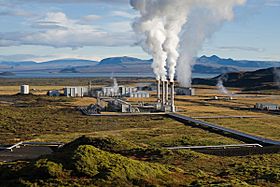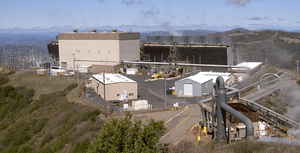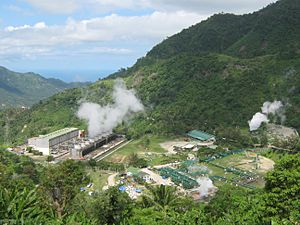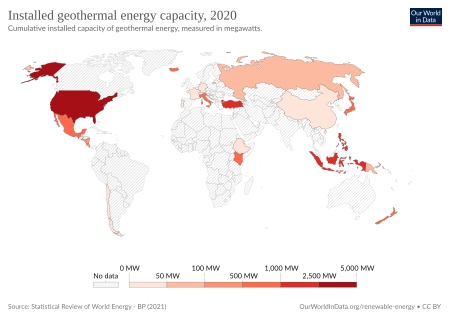Geothermal energy facts for kids


Geothermal energy (from the Greek roots geo, meaning earth, and from thermos, meaning heat) is energy made by heat inside the Earth's crust.
Although the Sun does heat the surface of the Earth, the heat from inside the Earth is not caused by the Sun. The geothermal energy of the Earth's crust comes 20% from the original formation of the planet, and 80% from the radioactive decay of minerals. The Earth is hottest at its core and, from the core to the surface, the temperature gets gradually cooler.
Resources of geothermal energy range from the shallow ground to hot water and hot rock found a few miles or kilometers beneath the Earth's surface, and down even deeper to the extremely high temperatures of molten rock called magma. It has been used for bathing from Paleolithic times, but is now better known for making electricity.
Geothermal energy escapes as hot water at many hot springs or as steam at geysers.
Contents
Uses
Almost everywhere, the ground 10 feet (3m) below the Earth's surface maintains a nearly constant temperature between 50° and 60 °F (10° and 16 °C). Geothermal heat pumps can tap into this resource to heat and cool buildings. A geothermal heat pump system consists of a heat pump, an air delivery system (ductwork), and a heat exchanger - a system of pipes buried in the shallow ground near the building.
Geothermal energy is also used directly for district heating, or in other heating and cooling applications. Buildings in Iceland are heated in this way from the country's many geothermal sites.
Hot water near the surface of Earth can be used directly for heat. Direct-use applications include heating buildings, growing plants in greenhouses, drying crops, heating water at fish farms, and several industrial processes such as pasteurizing milk.
In the winter, the heat pump uses power to remove heat from the heat exchanger and pumps it into the indoor air delivery system. In the summer, the process is reversed, and the heat pump uses power again to move heat from the indoor air into the heat exchanger. The heat removed from the indoor air during the summer can also be used to provide a free source of hot water. The power to run the heat pump comes from another source.
Power plants and thermal applications of geothermal energy are mature technologies, whereas enhanced geothermal systems (EGS) projects are a new type of application.
In the United States, most geothermal reservoirs of hot water are in the western states, Alaska, and Hawaii. Wells can be drilled into underground reservoirs for the generation of electricity. Some geothermal power plants use the steam from a reservoir to power a turbine / generator, while others use the hot water to boil a working fluid that vaporizes and then turns a turbine.
Hot dry rock resources occur at depths of 3 to 5 miles (5–8 km) everywhere beneath the Earth's surface and at lesser depths in certain areas. Access to these resources involves injecting cold water down one well, circulating it through hot fractured rocks, and drawing off the heated water from another well. Currently, nobody uses this method commercially. Existing technology also does not yet allow recovery of heat directly from magma, the very deep and most powerful resource of geothermal energy.
Geothermal power is electrical power generated from geothermal energy. Dry steam, flash steam, and binary cycle power stations have been used for this purpose. As of 2010 geothermal electricity was generated in 26 countries.
As of 2019, worldwide geothermal power capacity amounted to 15.4 gigawatts (GW), of which 23.86 percent or 3.68 GW were in the United States.
Geothermal energy supplies a significant share of the electrical power in Iceland, El Salvador, Kenya, the Philippines and New Zealand.
Geothermal power is considered to be renewable energy because the heat extraction is insignificant compared with the Earth's heat content. The greenhouse gas emissions of geothermal electric stations are on average 45 grams of carbon dioxide per kilowatt-hour of electricity, or less than 5 percent of that of coal-fired plants.
| Country | Capacity (MW) 2015 |
|---|---|
| United States | 17,415 |
| Philippines | 3 |
| Indonesia | 2 |
| Mexico | 155 |
| Italy | 1,014 |
| New Zealand | 487 |
| Iceland | 2,040 |
| Japan | 2,186 |
| Iran | 81 |
| El Salvador | 3 |
| Kenya | 22 |
| Costa Rica | 1 |
| Russia | 308 |
| Turkey | 2,886 |
| Papua New Guinea | 0.10 |
| Guatemala | 2 |
| Portugal | 35 |
| China | 17,870 |
| France | 2,346 |
| Ethiopia | 2 |
| Germany | 2,848 |
| Austria | 903 |
| Australia | 16 |
| Thailand | 128 |
| Country | Capacity (MW) 2021 |
% of national electricity production |
% of global geothermal production (2021) |
|---|---|---|---|
| United States | 3889 | 0.3 | 24.8 |
| Indonesia | 2277 | 3.7 | 14.5 |
| Philippines | 1928 | 12 | 12.3 |
| Turkey | 1676 | 10.7 | |
| New Zealand | 984 | 10 | 6.3 |
| Mexico | 976 | 3 | 6.2 |
| Kenya | 863 | 11.2 | 5.5 |
| Italy | 802 | 1.5 | 5.1 |
| Iceland | 756 | 30 | 4.8 |
| Japan | 481 | 0.1 | 3 |
| Costa Rica | 262 | 14 | 1.7 |
| Iran | |||
| El Salvador | 204 | 25 | 1.3 |
| Nicaragua | 153 | 10 | 1 |
| Russia | 81 | ||
| Papua New Guinea | 56 | ||
| Guatemala | 49 | ||
| Germany | 40 | ||
| Chile | 40 | ||
| Honduras | 39 | ||
| Portugal | 29 | ||
| China | |||
| France | 16 | ||
| Guadeloupe | 15 | ||
| Croatia | 10 | ||
| Ethiopia | 7 | ||
| Austria | 1 | ||
| Australia | 0 | ||
| Total | 15,644 |
Geothermal electric plants were traditionally built on the edges of tectonic plates where high-temperature geothermal resources approach the surface. The development of binary cycle power plants and improvements in drilling and extraction technology enable enhanced geothermal systems over a greater geographical range. Demonstration projects are operational in Landau-Pfalz, Germany, and Soultz-sous-Forêts, France, while an earlier effort in Basel, Switzerland, was shut down after it triggered earthquakes. Other demonstration projects are under construction in Australia, the United Kingdom, and the US. In Myanmar over 39 locations are capable of geothermal power production, some of which are near Yangon.
Environmental effects
Fluids drawn from underground carry a mixture of gasses, notably carbon dioxide (CO2), hydrogen sulfide (H2S), methane (CH4) and ammonia (NH3). These pollutants contribute to global warming, acid rain and noxious smells if released. Existing geothermal electric plants emit an average of 122 kilograms (269 lb) of CO2 per megawatt-hour (MW·h) of electricity, a small fraction of the emission intensity of fossil fuel plants. A few plants emit more pollutants than gas-fired power, at least in the first few years, such as some geothermal power in Turkey. Plants that experience high levels of acids and volatile chemicals are typically equipped with emission-control systems to reduce the exhaust.
Water from geothermal sources may hold in solution trace amounts of toxic elements such as mercury, arsenic, boron, and antimony. These chemicals precipitate as the water cools, and can damage surroundings if released. The modern practice of returning geothermal fluids into the Earth to stimulate production has the side benefit of reducing this environmental impact.
Construction can adversely affect land stability. Subsidence occurred in the Wairakei field. In Staufen im Breisgau, Germany, tectonic uplift occurred instead. A previously isolated anhydrite layer came in contact with water and turned it into gypsum, doubling its volume. Enhanced geothermal systems can trigger earthquakes as part of hydraulic fracturing. A project in Basel, Switzerland was suspended because more than 10,000 seismic events measuring up to 3.4 on the Richter Scale occurred over the first 6 days of water injection.
Geothermal power production has minimal land and freshwater requirements. Geothermal plants use 3.5 square kilometres (1.4 sq mi) per gigawatt of electrical production (not capacity) versus 32 square kilometres (12 sq mi) and 12 square kilometres (4.6 sq mi) for coal facilities and wind farms respectively. They use 20 litres (5.3 US gal) of freshwater per MW·h versus over 1,000 litres (260 US gal) per MW·h for nuclear, coal, or oil.
Images for kids
-
The Imperial Valley Geothermal Project near the Salton Sea, California.
See also
 In Spanish: Energía geotérmica para niños
In Spanish: Energía geotérmica para niños





